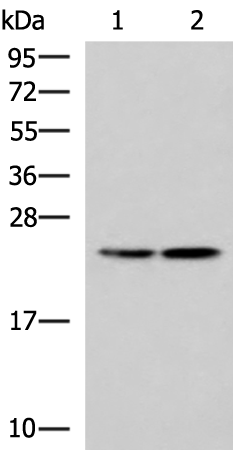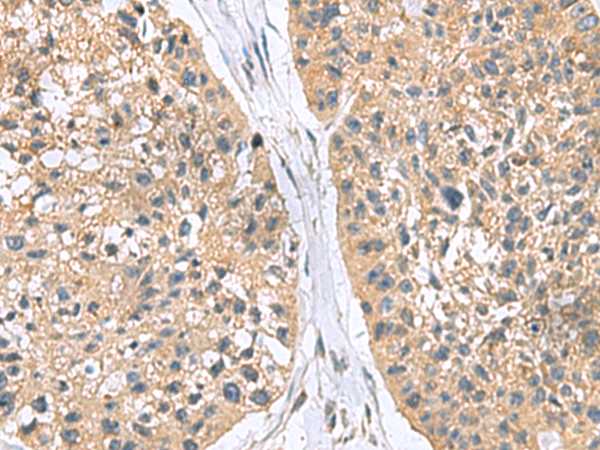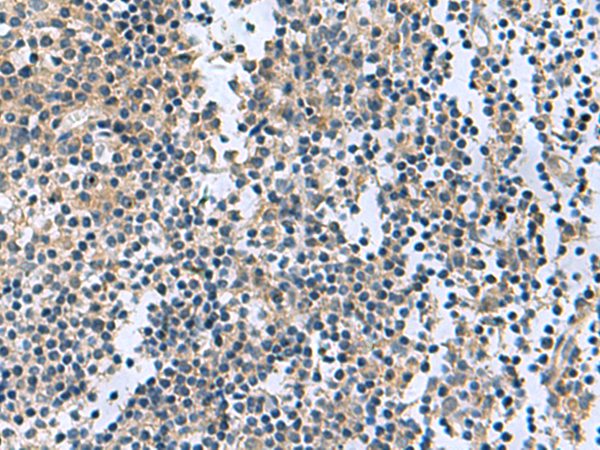


| WB | 1/1000-1/5000 | Human,Mouse,Rat |
| IF | 咨询技术 | Human,Mouse,Rat |
| IHC | 1/100-1/200 | Human,Mouse,Rat |
| ICC | 技术咨询 | Human,Mouse,Rat |
| FCM | 咨询技术 | Human,Mouse,Rat |
| Elisa | 1/5000-1/10000 | Human,Mouse,Rat |
| Aliases | G0S8 |
| WB Predicted band size | 24 kDa |
| Host/Isotype | Rabbit IgG |
| Antibody Type | Primary antibody |
| Storage | Store at 4°C short term. Aliquot and store at -20°C long term. Avoid freeze/thaw cycles. |
| Species Reactivity | Human, Mouse, Rat |
| Immunogen | Fusion protein of human RGS2 |
| Formulation | Purified antibody in PBS with 0.05% sodium azide and 50% glycerol. |
+ +
以下是3篇与RGS2抗体相关的文献摘要概括:
1. **文献名称**:*"RGS2 regulates serotonin signaling and hypothalamic-pituitary-adrenal axis function in mice"*
**作者**:Sinnarajah et al. (2001)
**摘要**:该研究使用特异性RGS2抗体验证基因敲除小鼠模型中RGS2蛋白的表达缺失,发现RGS2缺失导致5-HT受体信号异常,并影响应激激素轴功能。
2. **文献名称**:*"RGS2 overexpression attenuates angiotensin II-induced cardiac hypertrophy through inhibiting GPCR signaling"*
**作者**:Tang et al. (2010)
**摘要**:通过Western blot和免疫组化(使用兔源多克隆RGS2抗体),证实RGS2过表达可抑制血管紧张素II诱导的心肌细胞肥大,揭示其在心血管疾病中的保护机制。
3. **文献名称**:*"Tissue-specific expression and subcellular localization of RGS2 protein modulated by inflammatory stimuli"*
**作者**:Heximer et al. (2003)
**摘要**:利用抗RGS2抗体进行亚细胞定位分析,发现炎症因子可改变RGS2在血管平滑肌细胞中的核-胞质分布,提示其动态调节G蛋白信号的空间特异性。
(注:以上文献为示例,实际引用需核对原文)
Regulator of G-protein signaling 2 (RGS2) is a member of the RGS protein family, which functions as GTPase-activating proteins (GAPs) to negatively regulate G-protein-coupled receptor (GPCR) signaling. RGS2 specifically accelerates the hydrolysis of GTP bound to Gαq and Gαi subunits, terminating downstream signaling cascades involved in cardiovascular function, neurotransmission, and immune responses. Dysregulation of RGS2 has been linked to hypertension, anxiety disorders, and cancer, making it a therapeutic target of interest.
RGS2 antibodies are essential tools for studying the expression, localization, and functional roles of RGS2 in physiological and pathological contexts. These antibodies are widely used in techniques such as Western blotting (WB), immunohistochemistry (IHC), and immunocytochemistry (ICC) to detect endogenous RGS2 in tissues and cell lines. Specificity is critical, as RGS2 shares structural homology with other RGS family members. High-quality RGS2 antibodies are often validated using knockout controls or siRNA-mediated knockdown to ensure target specificity.
Commercially available RGS2 antibodies may target distinct epitopes (e.g., N-terminal or C-terminal regions) and recognize various isoforms or post-translationally modified forms. Researchers select antibodies based on experimental needs, species cross-reactivity (human, mouse, rat), and compatibility with specific applications. Recent studies using RGS2 antibodies have elucidated its roles in vasodilation, synaptic plasticity, and tumor progression, highlighting its therapeutic potential. Proper validation and optimization remain essential to minimize off-target effects and ensure reproducible results.
×